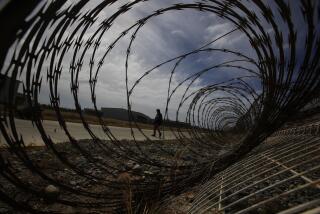U.S. Reportedly Will Fund Facilities on Honduran Territory : Plans for 3 Contras Island Bases Told
EL TIGRE ISLAND, Honduras â The United States will establish bases for Nicaraguan rebels on three strategically placed Honduran islands close to the Nicaraguaâs Pacific and Caribbean coastlines, according to Honduran officers and U.S. military sources.
The islands are El Tigre, less than a mile from the Honduran mainland and 12 miles from Nicaragua, and the two Swan Islands, 135 miles north of Honduras and about 175 miles from Nicaragua, said the sources, who spoke on the condition that they not be identified.
The islands have figured in highly controversial covert CIA operations--El Tigre in the mining of Nicaraguan harbors and the Swans in the ill-fated Bay of Pigs invasion of Cuba.
Supply Depots
El Tigre is to be used as a supply base and as a launching point for attacks by the contras against troops of Nicaraguaâs leftist Sandinista government. The Swan Islands will be used as a rebel supply depot.
The funding for both operations will come from the $100 million in aid given recently to the contras by Congress at the urging of President Reagan, the sources said.
Arthur Skop, a spokesman for the U.S. Embassy in the Honduran capital, Tegucigalpa, acknowledged that there is already a U.S. base on El Tigre, but said it contained only a âsmall military element.â He would not say what purpose the base serves, but U.S. and Honduran intelligence officers say that it is a listening post for monitoring Sandinista radio traffic and other communications.
Skop said that a mobile radar unit was installed on El Tigre during the Big Pine II joint military exercises conducted by the United States and Honduras in 1983, but was removed in 1984 and has not been replaced.
Operations Failed
Both CIA operations involving the islands were failures. El Tigre was the main base for the mining of Nicaraguaâs harbors in 1983 and 1984. The action was condemned by the World Court in The Hague and spurred Congress to suspend aid to the contras in October, 1984.
The Swan Islands were used by the CIA in 1961 in the Bay of Pigs invasion of Cuba by Cuban exiles. The invasion was crushed by Fidel Castroâs forces in three days and nearly 1,300 of the invaders were captured and imprisoned.
A ban against foreigners landing on El Tigre was breached last Sunday by two journalists who took their boat to a deserted beach and walked into Amapala, the islandâs main town.
There they were told by Mayor Leo Valecillo that reports of the islandâs new role were the talk of the town.
Valecillo said he hopes the reports are not true. âWe would fear an attack,â he said. âWe pray to God it wouldnât happen, but if the Sandinistas knew the contras were here, they might attack us. They could bomb us.â
Built New Road
Residents told the journalists that last July, officials from the U.S. base made a rare visit to Amapala to hire local workmen to build a three-mile gravel road linking the U.S. facility with the town and the Amapala Honduran naval base. Valecillo said workers were also hired to dig wells and install pipes to the facility, which had previously brought all its food and water in by helicopter.
The base sits on a mountain facing the Pacific Ocean and the mouth of the Gulf of Fonseca.
Valecillo said that residents first thought of the economic benefits when they heard the contras might come to his island.
The deep water port serving Hondurasâ Pacific coast was moved from Amapala to nearby San Lorenzo five years ago, and only 100 of the islandâs 5,394 people are now employed. The daily per capita income has dropped from 33 cents to about 13 cents.
âThey say where there are contras, there are dollars,â Valecillo said. âBut we donât want to become another El Paraiso. The people are afraid.â
El Paraiso is a province in southern Honduras where more than 12,000 Hondurans have fled a once-prosperous coffee farming zone because of repeated Sandinista attacks against about 16,000 Nicaraguan rebels based there.
More to Read
Sign up for Essential California
The most important California stories and recommendations in your inbox every morning.
You may occasionally receive promotional content from the Los Angeles Times.










